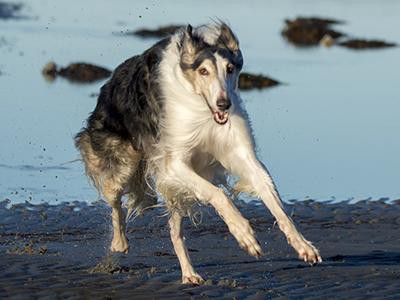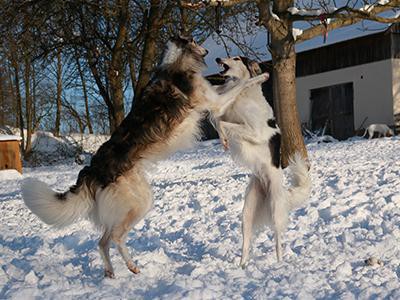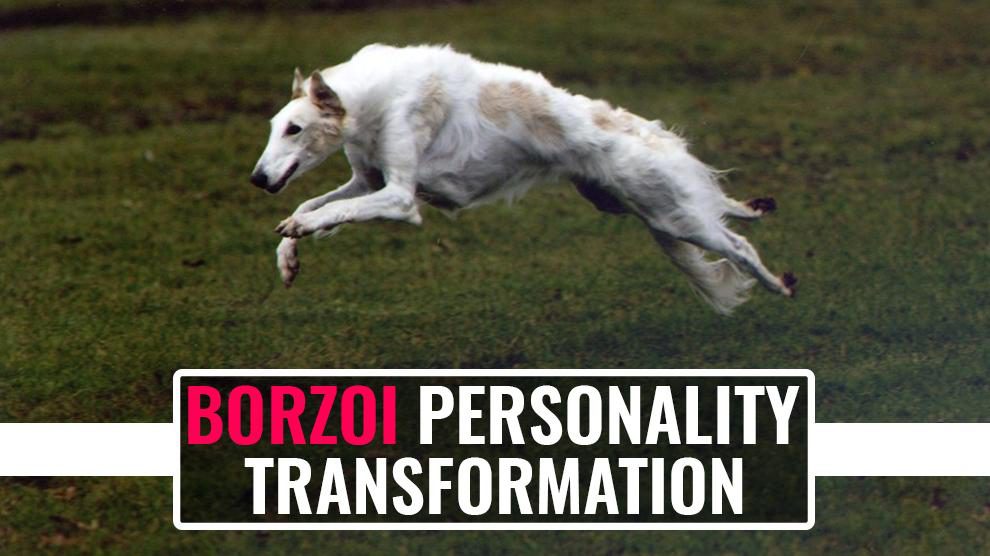Dog Pregnancy Calculator And Timeline
From the luxurious homes of the Russian nobility and shared limelight besides the rock ‘n’ roll royalty, these long-legged tail-waggers have come a long way.
They look like a million bucks with their long, slender physique and flowy, silky medium-length coats.
Because of their impressive height, they literally stand out from the canine crowd and they stand at over 30 inches from toes to shoulder. The Irish wolfhound is the tallest sighthound breed, and then comes the beasty Borzoi.
Possessed of quiet dignity and independence, the Borzoi is sometimes compared to a cat. (Obviously, a very tall cat!)
Also known as Long-Haired Greyhounds and Russian Wolfhounds, the name Borzoi translates from the Russian word – borzoi or borzii to “quick or swift”.
The Borzoi is the only Russian Greyhound breed (others are South Russian Greyhound, Chortaj, Tazy, and Taigan) to become popular outside Russia.
Similar to the Afghan hound in appearance, the main difference is Afghans typically have extremely long coats with relatively stripped tails, while borzoi doesn’t have long coats but have long, glossy tails.
They were the definitive status symbol of dogdom in their day. Now they are rarely seen outside Russia, but they still radiate an air of exciting days gone by.
Unless, when they see a mud pit and decide to welter in it, because underneath their entire aristocratic propensity, they tend to be clowns at heart.
How Borzoi Dogs Were Used In Hunting?
Leo Tolstoy illustrates a hunt with a Russian wolfhound in “War and Peace” like this:
“Halloo!’ Nikolai shouted in a voice not his own, and of itself his good horse raced headlong down the hill, leaping over gullies, to head off the wolf; and still more quickly, outstripping the horse, raced the dogs. Nikolai did not hear his own shouts, did not feel that he was galloping, did not see the dogs or space over which he was galloping; he saw only the wolf who, quickening his pace, loped down the hollow without changing direction.”

The tradition of hunting with Borzoi dogs have come to us from the depths of history.
When you think of Borzoi, the first thing that will surface in your mind is the image of Tsar’s Russia and the hugeness of those woods.
In an otherwise quiet area of the western Russian woods, when you hear high-pitched yips and deep growls springing up from a cluster of trees, you can guess the hunt is on… Nobles riding horses.
A few tall and strong dogs with passion dashing beside. With elongated necks and expanding nostrils, muscles stretching tight, sometimes with raised ears lurking for a sound. Their dark velvety eyes scanning the horizon.
You can feel the tense of the hunt in the air. And then, their slender bodies slice through the air.
During the hunt, the only thing that exists is the stillness in the air that holds the continuous gallop, the squeaking saddle and the hard breath of horses. With unbelievable speed and agility, they run down and hold wolves and foxes by their throat in the cold climate.
The wolfhounds may get bitten during the hunt. They may return blood soaking from their muzzles or with broken bones.
Wild-eyed and wet with slobber, trotting to their masters, they will be sure to ready for the next hunt in a few days time. They live to fight for another day.
However, good news for them is…. hunting is rare nowadays and borzoi dogs are quietly resting in Russian homes with their bones intact.
History Of Hunting With Borzoi Dogs
This is one hunting style that used Sighthounds, first emerged, perhaps, in Arab homelands and spread to the countries of Russia following the Mongol or Tatar yoke. Obviously, they came from the east to despoil, butcher and plunder.
The Western historiography has long been decisive of the overriding negative view on the Tatar–Mongol Golden Horde (led by Genghis Khan) rule over Russian principalities.
Earlier historians depicted ‘The Tatar yoke’ as the most horrible period in Russian history.

Nowadays, intelligentsia and contemporary historians worrying out loud about the dim view Russians take of Tatarstan. So what did the Tatars (or their warrior ancestors-Mongols, if you prefer) bestow Russia?
Many historians give out different responses. But, we would like to say…it is Borzoi dogs.
Many peace-loving Tatar and Uzbek horse lovers who just happened to wander west moved to Russia with their dogs. During the 17th century, the Russians started to breed the borzoi – the main breed of domesticated dog used for this kind of hunt.
Ever since hunting with dogs became a popular recreation for the Russian aristocrats and the tsars.
What Hunting Skills Does A Borzoi Have?
For many centuries, Borzoi has been the only hunting dog in their region, which is why it embodies such qualities of a universal hunter as keen eyesight (they always keep their eye on the prey), agility, prowess, and rage during the chase and high speed as well as an ability to leap.
Borzoi easily chases down the wolves, foxes, and hares, while the best of Borzois will surely go after a saiga and even a cheetah.
Speed and Agility are not the only advantages of Borzois. Their distinctive characteristics are long run, prey retrieval abilities, driving out a hiding animal from thickets and they are particularly exceptional in short runs.
Borzois are capable of not only gripping the prey after a high-speed chase on distances but also retrieving it to the hunter.
If Borzoi catches larger prey, because of its compliance and composure, it will simply wait for the Master while other European breeds have the inherent programming of tearing off flesh and eating it, before the arrival of their Master.
Methods Of Hunting
There are two distinctively different methods were used in hunting: one called field hunting, where the hunters, mounted on horses, progress in the open, fenceless woods in a long skirmish line slipping their hounds on whatever coming up.
The dogs press forward walking or slow trotting about two hundred yards apart in a skirmish line that is half-moon-shaped.
Another method is that huntsmen mounted in ponies would be covertly stationed on all sides with Borzoi in slips. When there is any sight of wolves, two dogs and a bitch that make ‘the team’ would be off leash like raging bulls.
The dogs that comprise of ‘the team’ will be nearly matched in color and confirmation as possible. Usually, foxes, hares, and deers are more often coursed than wolves.
Borzois would be typically followed by the pack of Anglo-Russian foxhounds. The hunters are dressed in typical Russian costumes – spurred and booted, fur-trimmed hats, and equipped with a whip, dagger, and hunting-horn.
Seated looking fiercely on the backs of their Kirghiz ponies, the hunters mounted on padded Cossack saddles would make a picture that once seen is not easily forgotten.
After arriving at the scene of the hunt, the hunters are stationed by the ‘captain of the Hunt’ at intervals of a hundred yards or so until the entire grove is surrounded by a long cordon of hounds and riders.
A signal note is played on a hunting horn, and with shouts of men, the cracking of whips and the mingled music of the trail hounds, the foxhound pack is urged into the grove in pursuit of hidden game.
The hunt is started …. When the sight of the hidden game is got and the foxhounds in full flow chasing the foxes or wolves or deers, the sound of hound voices is suddenly changed to a sudden sharp yapping of the pack in full cry.
Out of the blue, there springs a dark grey speedy beast from the covert some hundreds of yards away- Borzoisssss
There is a rush, a pounce and with a yelp – the primary hounds are sent into the business; the attack is on and what happens is a confused mass of white and grey leaping forms with snapping fangs puzzling the quarry.
With a fierce neck-hold, borzois pull down the quarry and they do their best to hold the wolf prostrate. Foxes and hares are captured in the same manner by the Borzois, but, in that case, a toss in the air is usually sufficient.
Then, in a feistier dash, the hunter literally flings himself from the saddle of his hunting pony onto the prostrated wolf.
The hunter with instant dexterity uses a small stick with a thong at each end and grabs the quarry, and ties the thong at the back of that brutes’ neck.
If the prey (wolf, fox or a deer) made it back to the forest, a borzoi had no chance to catch it – the fast dog would smash itself dead against the trees.
As borzoi dogs were very expensive, hounds were used to hunt in the woods. In that case, hounds would chase the game and make it run in the direction of an open field.
Then, the positioned covert borzoi dogs will chase it and hunters shoot it from a distance.
In southern Russia, particularly in the vast steppes from the west of the Caspian, the north Caucasus up through the Don River and Volga estuaries, there was an abundance of game and the Steppe Borzoi excelled in the time-honored Cossack tradition of coursing.
The hunters used a brace of sighthounds and a falcon rather than a rifle, a method taken further west by the Tartars.
In this case, the Borzoi drive out the game to the open area where the falcon, flown at the right time, grabs the prey or hinders the prey from running by sitting on his body and the hound finally catches the game.
This is said to be the most spectacular and successful way of hunting. Owning Borzois, and employing people to train them and take them hunting, was very expensive.
It cost approximately 1,500 rubles a year during the mid-19th century – that was half of an army colonel’s annual pay.
Now, again with Tolstoy, from his book:
“The old dog, his matted fur hanging from his haunches, headed off the wolf and was now within five paces of him. The wolf, as if sensing the danger, gave Karai a sidelong glance, tucked his tail still further between his legs, and increased his pace. But here – Nikolai only saw that something happened with Karai – he was instantly on top of the wolf and rolled head over heels with him into a ditch in front of them.”
In this passage, a Borzoi named Karai made his extraordinary leap. Incidentally, this canine in “War and Peace” is an inspiration from a fabulous dog named ‘The Beast’ that lived in the late 18th century.
What Can You Do With A Borzoi In Recent Times?
There are several organized activities you can participate in with your Borzoi. Some are competitive and others are just for fun. Classes and training are available from various sources in each of these endeavors.
- Lure Coursing
Lure coursing is the game of having dogs pursue a mechanized lure and provides your dog to find its inner hunter and get some exercise.
Present lure courses make use of an artificial plastic lure or fur lure pulled by a battery-powered pulley across an open field– stimulating the thrill of the hunt of a game in a controlled, safer environment.
Recreational lures are pulled in short straight practice patterns about 100-400 feet in distance. In competitions, longer more complex patterns are used with a series of pulleys used to power a course of 500-800 yards in length.
The live game/quarry is still pursued in some areas. And it’s not just for sighthounds any longer – lure clubs are established for dogs of all breeds. You can build your own lure course in your back yard or join a local club and let your dog compete recreationally.
- Confirmation
Each dog is evaluated on its relative proximity to the model customized in the Borzoi breed standard. The judge submits a judgment and honor ribbons to the top dogs at each level of competition.
- Obedience Training
Dogs learn to sit, stay, come when called and walk on a leash. At the more advanced stages, they also go as directed, jump hurdles, retrieve objects and walk with owner off leash.
When you are obedience training the Borzoi, the success will improve if you adjust your methods to recognize the Borzoi’s independence and intelligence.
Shorter, consistent and more diverse training periods will help increase the effectiveness and maintain their focus of your work.
- Agility Training
The dogs navigate a series of obstacles under the direction of their Trainer. Obstacles include tunnels, hurdles, weaving poles, seesaws, suspended and A-frame planks.
- Therapy Dog
As a therapy dog, your Borzoi can bring the healing power of a dog companionship; however, first, your Borzoi must complete basic obedience training and be tested for soft collar work.
On a final note:
These Russian sighthounds have never experienced proper care or veterinary care, never known food manufactured just for them and have always been bred for hunting performance.
Their survival indicates their physical robustness, anatomical soundness and they represent a unique gene-pool, a source for good both from a sporting and a health point of view.
Sadly, we more and more inflict our moral vanity on the under-developed animal world and show increasing impertinence, this is high time to take stock and pull up our socks.
Recently, in a show ring, one of the judges’ critiques about Borzois is really disturbing: “The graceful power on the move seems to have vanished…” with another judge mentioned, “too much importance being placed on abundant amounts of the coat…”
When these sighthounds are bred with least regard given to wolfhound anatomy and for their physical soundness, we are heading for the annihilation of such remarkable breeds in the immediate future.


















